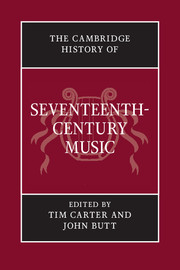Book contents
- Frontmatter
- 1 Renaissance, Mannerism, Baroque
- 2 The seventeenth-century musical ‘work’
- 3 Music in the market-place
- 4 Music in new worlds
- 5 Music and the arts
- 6 Music and the sciences
- 7 The search for musical meaning
- 8 Power and display: music in court theatre
- 9 Mask and illusion: Italian opera after 1637
- 10 The Church Triumphant: music in the liturgy
- 11 Devotion, piety and commemoration: sacred songs and oratorios
- 12 Image and eloquence: secular song
- 13 Fantasy and craft: the solo instrumentalist
- 14 Form and gesture: canzona, sonata and concerto
- Appendix I Chronology
- Appendix II Places and institutions
- Appendix III Personalia
- Index
- References
7 - The search for musical meaning
Published online by Cambridge University Press: 28 March 2008
- Frontmatter
- 1 Renaissance, Mannerism, Baroque
- 2 The seventeenth-century musical ‘work’
- 3 Music in the market-place
- 4 Music in new worlds
- 5 Music and the arts
- 6 Music and the sciences
- 7 The search for musical meaning
- 8 Power and display: music in court theatre
- 9 Mask and illusion: Italian opera after 1637
- 10 The Church Triumphant: music in the liturgy
- 11 Devotion, piety and commemoration: sacred songs and oratorios
- 12 Image and eloquence: secular song
- 13 Fantasy and craft: the solo instrumentalist
- 14 Form and gesture: canzona, sonata and concerto
- Appendix I Chronology
- Appendix II Places and institutions
- Appendix III Personalia
- Index
- References
Summary
In 1488 or thereabouts, the renowned poet and Humanist Angelo Poliziano attended a banquet held by Paolo Orsini in Rome. The occasion included music, which Poliziano described enthusiastically to Pico della Mirandola, noting in particular the performance of the host’s son, the eleven-year-old Fabio:
No sooner were we seated at the table than [Fabio] was ordered to sing, together with some other experts, certain of those songs which are put into writing with those little signs of music, and immediately he filled our ears, or rather our hearts, with a voice so sweet that … as for myself, I was almost transported out of my senses, and was touched beyond doubt by the unspoken feeling of an altogether divine pleasure. He then performed a heroic song which he had himself recently composed in praise of our own Piero dei Medici… His voice was not entirely that of someone reading, nor entirely that of someone singing: both could be heard, and yet neither separated one from the other; it was, in any case, even or modulated, and changed as required by the passage. Now it was varied, now sustained, now exalted and now restrained, now calm and now vehment, now slowing down and now quickening its pace, but always it was precise, always clear and always pleasant; and his gestures were not indifferent or sluggish, but not posturing or affected either. You might have thought that an adolescent Roscius was acting on the stage.
- Type
- Chapter
- Information
- The Cambridge History of Seventeenth-Century Music , pp. 158 - 196Publisher: Cambridge University PressPrint publication year: 2005
References
- 1
- Cited by

